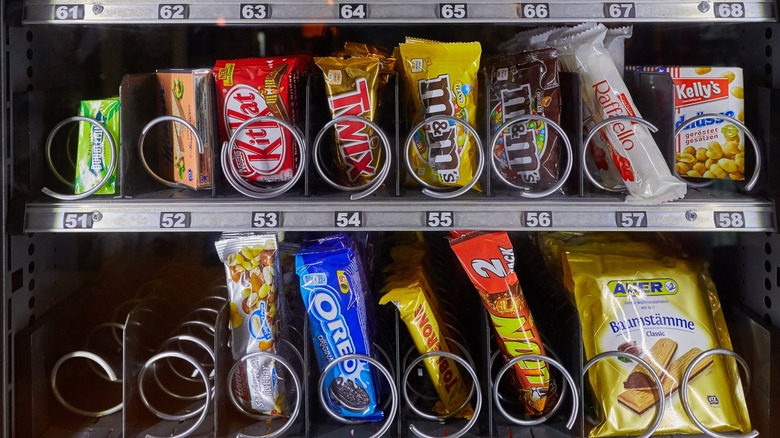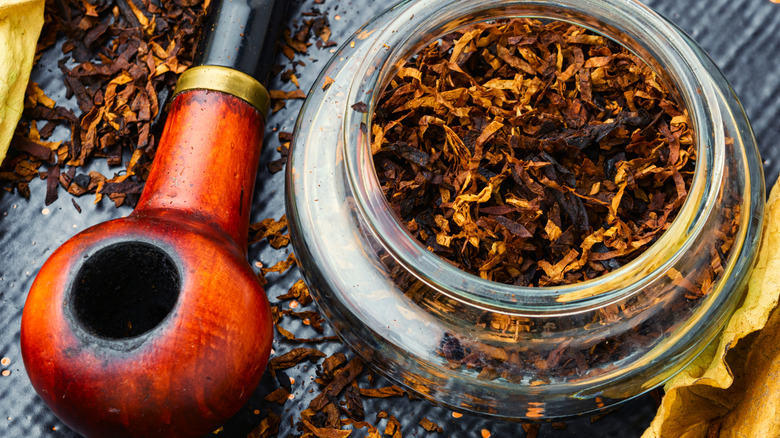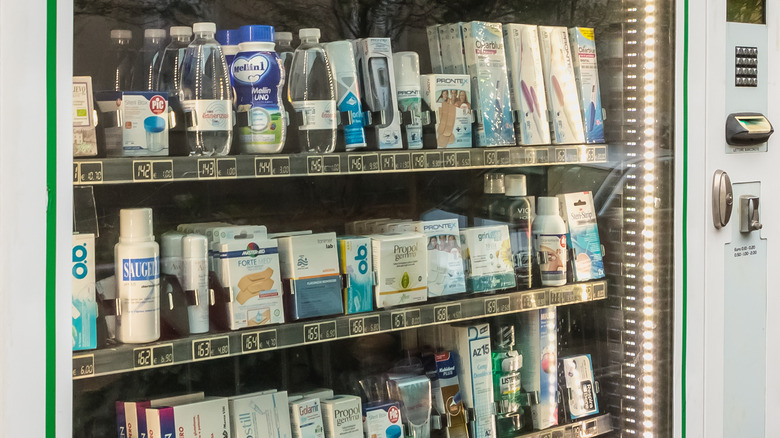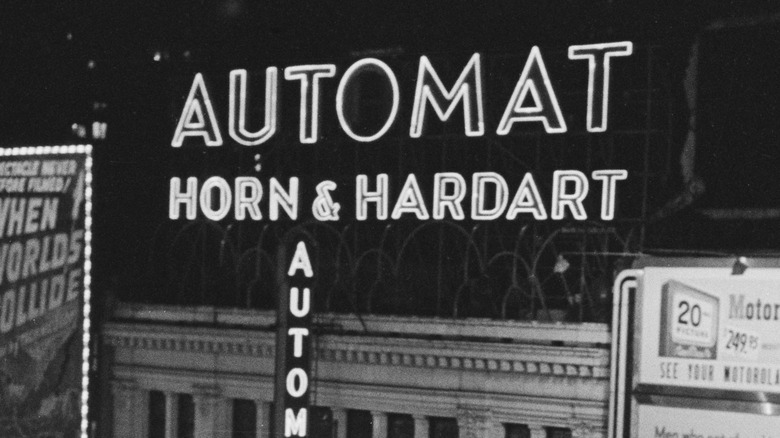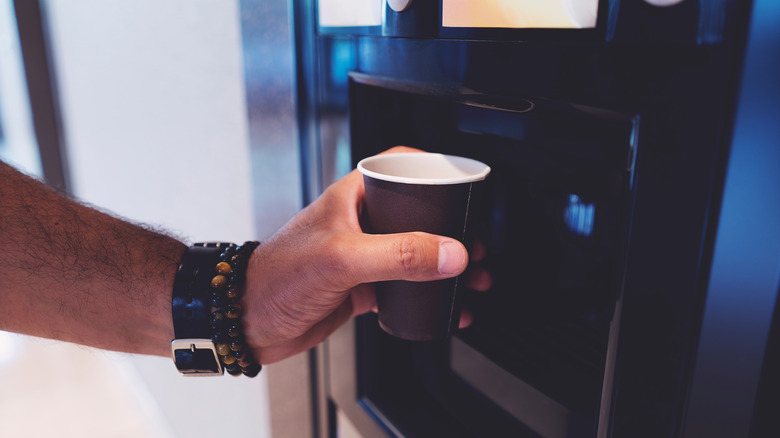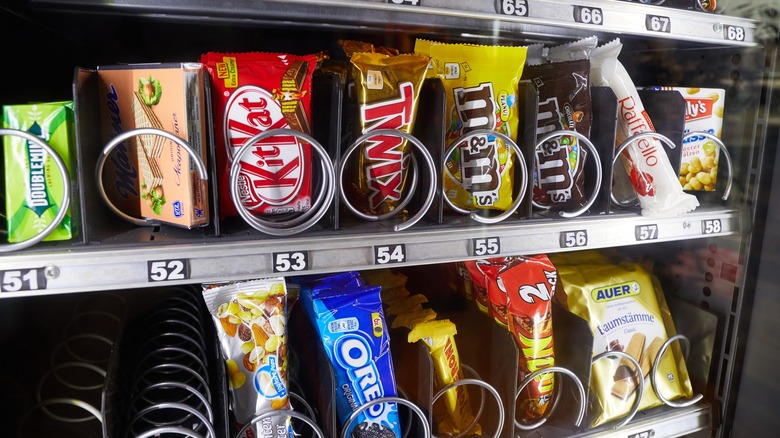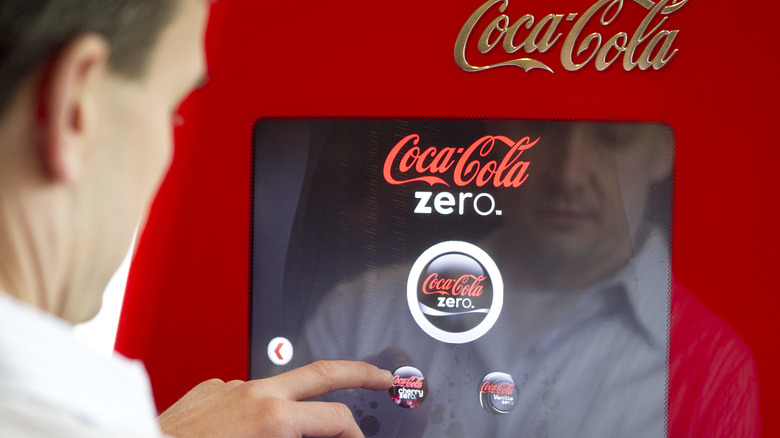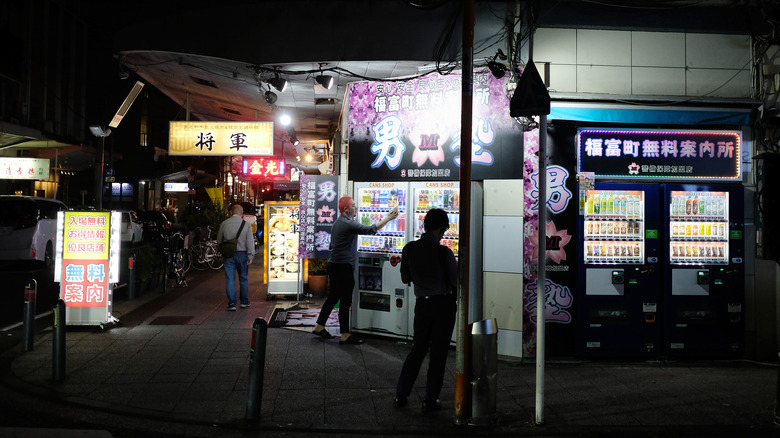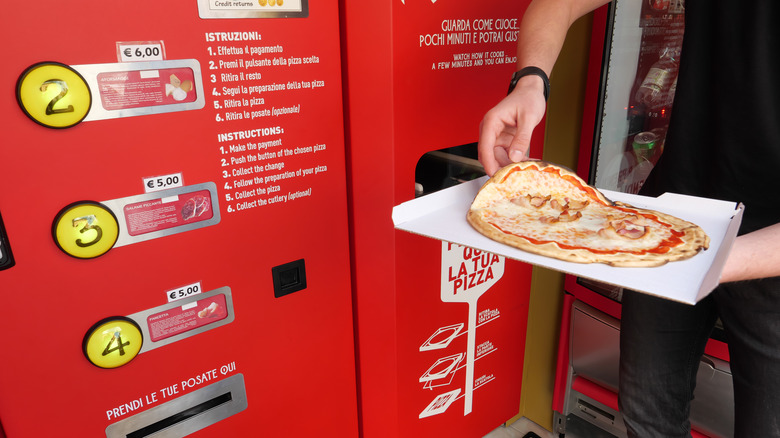The Untold Truth Of Vending Machines
They're easy to take for granted (perhaps because its assumed they've always been a part of American life), but it's time to recognize vending machines as the marvel they are. Standing against a wall in a hotel, store, dormitory, office, or the basement of a large building, vending machines offer snacks, drinks, and other items just when they're needed the most. When a person can't step away to a store or restaurant, or they only have a moment to spare, or they don't want to make a face-to-face transaction, vending machines are there for us. They're the ultimate in convenience technology, feeding and hydrating humans when few other options are available. Of course, "vending machine" can also be used to describe all number of fun and important devices, from those insert-coin-and-twist-the-knob candy dispensers to claw machines to automated pay-by-the-cup coffee makers; it's hard to imagine life without them.
Vending machines have actually been around for a very long time in a great number of forms, and they've evolved into sophisticated and varied sales tools across the world. Here's a look at the delectable history of vending machines — no exact change or smoothed-out dollar bill required.
Vending machines originated in ancient Rome
In the first century A.D., an engineer named Hero (or alternately, Heron), who lived and worked in the Egyptian city of Alexandria (at the time under Roman rule), built a reputation as one of the finest inventors in antiquity. Among his creations: an early syringe, a prototypical steam engine, and the first recorded example of what could be called a vending machine — a device in which money was exchanged for an automatically dispensed good.
The Roman Empire had been using official coinage as currency for about 500 years when Hero figured out how to use them to trigger a retail apparatus. According to Smithsonian Magazine, a Roman would put their coin into the slot at the top of a small box. The coin was heavy enough to strike a metal lever, which would tip to one side, pulling a stopper out of a hole, letting liquid flow freely. As the water dispensed, the metal lever would slowly right itself and the coin would fall off the beam, ending the flow and the transaction. Hero's vending machine was placed outside religious temples, and the liquid sold was holy water.
Vending machines sold loose tobacco in the 1600s
Well before food and beverage were the most common vending machine offerings, tobacco was a driving force in the development of mechanical purchasing. According to Kerry Segrave's "Vending Machines: An American Social History," the first major development in the field (following ancient Roman automatic holy water dispensers), were coin-operated snuff boxes that showed up in inns and taverns throughout England in the 1610s. The tech used is somewhat similar to today's newspaper vending machines, in which the customer puts in their coins and is trusted to take only what they paid for. A person would pop a coin into a slot at the top of the box, which activated a trigger that opened the hinged lid. That revealed a box full of tobacco, and the patron would grab a single plug under the watchful eye of the innkeeper or publican who would shut the box and move it along to another customer.
This early vending tech resurfaced, slightly improved, in England in the 1830s. Still based on an honor system but not requiring supervision, a predetermined coin of a particular denomination opened the box, revealing stacks of prepackaged tobacco pockets. These spread to New York by the 1840s, making them the first vending machines in the United States.
Gum vending machines hit America in the late 19th century
It took more than a millennium after their invention for humans to figure out that vending machines could be used to sell consumable food and drink, a development that would also mark the beginning of vending machines in the United States. The first American patent for a vending device was granted to W.H. Fruen in 1884, according to Bon Appétit, for his "Automatic Liquid Drawing Device." In sketches, Fruen's machine resembled a walk-up apartment building. It worked similar to the one made by Hero of Alexandria — a coin was dropped into the machine, which triggered a falling lever, causing the coin to roll away and open a valve to seep liquid into a cup (placed on the front stoop of the tiny apartment building).
Fruen's machine was never mass-produced or distributed, but four years later, vending machines offering Tutti-Frutti gum were erected in train stations in New York City. By 1894, the automatic gum machines, which operated with a distinctive "delivery slide," where the product would shoot down upon purchase, had proved so popular that the gum company renamed itself the Tutti Frutti Automatic Vending Company.
There were once vending machine restaurants
Vending machines offer food fast, so it makes sense their basic technology was the engine for one of America's first fast food chains. Primarily found in East Coast big cities during the first half of the 20th century, an "automat" was a place hungry people could hit up for a quick, cheap, no-fuss meal. According to Serious Eats, automats (short for "automatic") were set up like cafeterias — all the food was made in a kitchen and then placed in small, closed compartments. Customers went through the different sections of the automat, placing a few coins into a box which would open the glass-fronted compartment of their choice, allowing them to reach in and grab a sandwich, soup, sides, and desserts. The first American automat, one of many eventual Horn & Hardart outlets, opened in Philadelphia in 1902. Its founders were inspired by similar operations in Europe called "waiterless" restaurants, according to the New York Public Library.
When fast food burger joints like McDonald's took hold in the 1950s, it spelled the end for sit-down-to-eat quick spots like automats. The last Horn and Hardart in Philadelphia closed in the 1960s, and the chain's final outlet remained in New York City as a nostalgic tourist attraction until 1991.
Coffee vending machines took off in the 1940s
Coffee vending machines — those bulky contraptions that provide a freshly-brewed, freshly-poured up of caffeine at any time — followed (and were inspired by) cold drink dispensing devices. According to the Chestnut Hill Local, Cyrus Melikian was serving in the Air Force in 1944 and was stationed at Wright Field in Ohio. One fateful day, he couldn't buy a cup of coffee at the base exchange because it wasn't during a mealtime. He and a friend, Lloyd Rudd, got sodas from a vending machine instead, and after doing some research, according to Melikian, they learned that hot beverage dispensers "simply did not exist at that time." After discharges in 1946, the two pals started a company, raised $55,000 from investors and their own savings accounts, and after nine months of tinkering, made a coffee machine in Melikian's basement. They set it up at a Philadelphia Eagles game and sold coffee for 10 cents a cup. Within a year, the duo had a factory churning out 40 machines a week, and their machines took in $1 million a year.
Melikian kept improving on his design. Up to that point, his devices used instant coffee powder with hot water added at the moment of purchase. Then Melikian devised a coffee concentrate (per the Philadelphia Inquirer), and, after selling the operation and starting a new company, he created the first single-serving coffee pods, the forerunner of today's K-cup machines.
Americans prefer vending machines to stock junk food
Vending machines literally sell any number of physical objects — Best Buy sells cameras and headphones in airport-based automated kiosks, for example. Countless machines even dispense "healthy" food choices, like fresh juice or apples. But the numbers don't lie — when staring at the options offered to them at a vending machine, Americans are vastly more likely to select sugary candy bars, salty snack chips, or other tasty, comforting items one could classify as "junk food."
According to 360 Connect, the most popular snack items sold in vending machines in the U.S. are Snickers bars, Clif Bars (protein-enriched but sugar-loaded "energy" bars), Pop-Tarts, Sun Chips, and Reese's Peanut Butter Cups. The list of bestselling items from trade publication Vending Connection varies a bit in items but not premise, with M&M's, Reese's Peanut Butter Cups, Doritos, Lay's potato chips, and the ever-popular Hershey's Chocolate Bar comprising its top five.
Coca-Cola's Freestyle machine is technological marvel
Starting in 2009, hundreds of fast food outlets did away with their standard soft drink fountains, where either an employee, or the customer themselves, would place a cup under a spout, trigger a button, and one of about six to eight flavored syrups would flow into the cup simultaneously with soda water to create an on-demand Coke, Diet Coke, Pepsi, or the like. Instead, restaurants outsourced their beverages to Coca-Cola, who installed massive, free-standing, self-serve Freestyle kiosks. A great leap forward in terms of vending machine technology and product availability, according to Fast Company, the Freestyle initially allows for more than 100 flavors and drink options. No longer bound by the confines of half a dozen taps, the machine offers flagship Coke products, flavor-spiked water, energy drinks, varieties not available in the U.S., and combinations not readily available otherwise for years, if at all.
Featuring an interactive touchscreen to help users sort through the dozens of possibilities, the Freestyle offers some extremely sophisticated "PurePour" technology. The tech was first created for the medical industry to help doctors and nurses measure, with extreme and important precision, the amount of dialysis and cancer drugs to give patients. The Freestyle also uses infrared scanners and computer chips and is internet-enabled so that Coca-Cola headquarters in Atlanta can receive and process data about what beverages people are consuming the most, as well as when and where.
Vending machines are extremely popular in Japan
They just kind of stand there, passively offering items and consumables for sale, and they've become a huge moneymaker. According to CBS News, about 7 million vending machines can be found in the U.S., and they pull in about $22 billion annually. But that's nothing compared to Japan, where vending machines are an enduring cultural phenomenon and part of the landscape of everyday life. There's one vending machine for every 30 people in Japan; in the U.S., it's closer to 1 in 50.
In Japan, a small amount of yen can purchase just about anything edible, including items like canned coffee and bottled water, as well as soup, fresh fruit, and jars of artisanal broth with an entire grilled fish packed inside. Choices like those — as well as relatively exotic snacks like beetles, grasshoppers, and scorpions — are reportedly easier to find than American vending machine hallmarks like candy and chips. Trinkets, toys, and collectibles are also sold in large numbers in vending machines in Japan. You can buy trading cards, posters, stuffed animals, and craft kits at a kiosk, as well as fancier stuff like perfume and jewelry.
Vending machines are highly adaptable, of course, and what's specifically sold in them varies by country and local demand. For example, in Germany, egg vending machines are a thing, herb seed kiosks can be found in Greece, and in Hong Kong, customers can purchase a Nintendo Switch without any human interaction.
You can get a fresh baked pizza from a vending machine
Vending machines have traditionally dispensed prepackaged shelf-stable foods. About the only hot and fresh things available in such a fashion were coffee or hot chocolate. But in the 21st century, food preparation and cooking automation technology developed to the point where numerous companies operated completely automated, self-service pizza vending machines, or, as Canadian manufacturer PizzaForno calls them, "automated pizza ovens" (via The Spoon). With about three dozen kiosks in Canada and Michigan, the machine features a touchscreen for customers to order one of many different varieties of pizza. Simply pay around $12, and let the machine goes to work. It pulls from a stockpile of about 70 pre-made pies and then uses air fryer-like convection heating to cook the whole thing in just about two minutes.
Another company, Let's Pizza, operate kiosks roughly twice the size of a typical snack-dispensing vending machine, but that's because it needs the room for a full-service, miniature, robotic pizza kitchen. Viewing windows allow customers to watch the entire three-minute process. After selecting a pizza style (from around four choices) and paying, the machine makes the pie to order from scratch, mixing and rolling the dough and then applying sauce, cheese, and toppings before a rapid bake.
